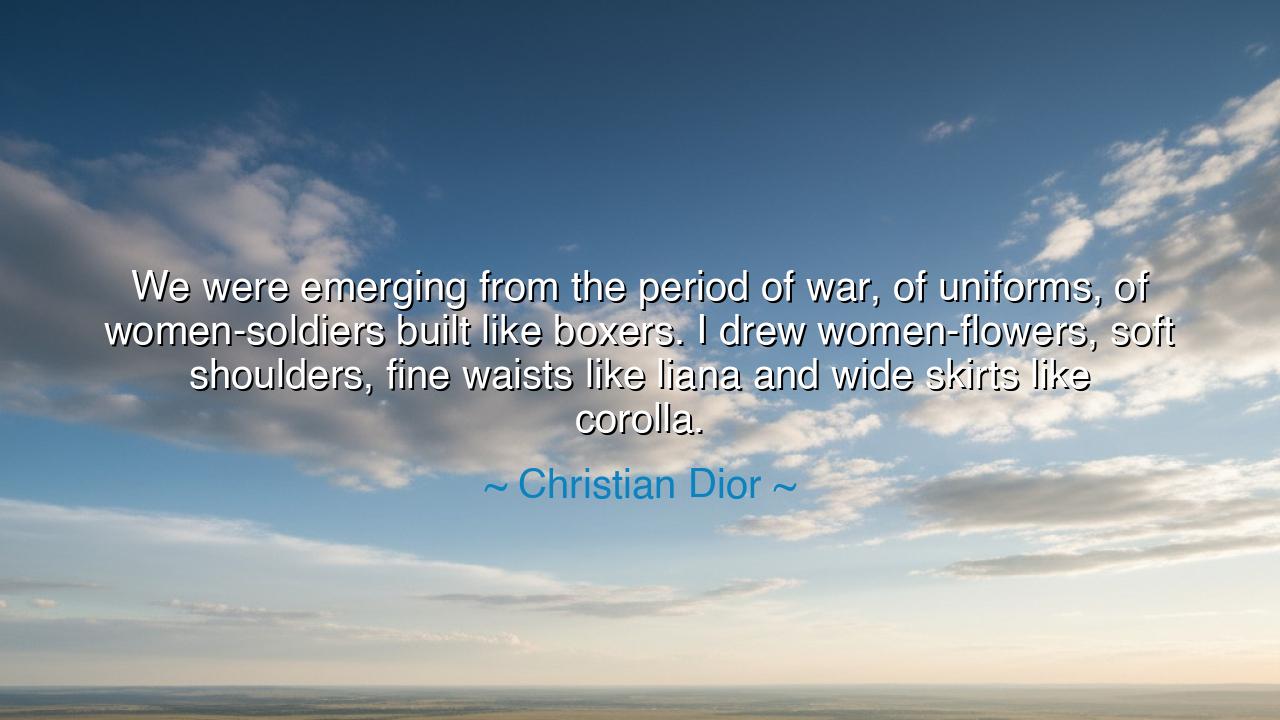
We were emerging from the period of war, of uniforms, of
We were emerging from the period of war, of uniforms, of women-soldiers built like boxers. I drew women-flowers, soft shoulders, fine waists like liana and wide skirts like corolla.






The master of elegance, Christian Dior, spoke with the vision of an artist when he declared: “We were emerging from the period of war, of uniforms, of women-soldiers built like boxers. I drew women-flowers, soft shoulders, fine waists like liana and wide skirts like corolla.” In this utterance, Dior revealed the spirit of his age: the longing for beauty after brutality, for gentleness after steel, for grace after years of sacrifice and deprivation. His words are not only about fashion, but about the rebirth of the human soul after the long night of war.
The Second World War had left Europe in ruin. Rationing stripped away luxury, uniforms replaced gowns, and necessity hardened the appearance of men and women alike. Women worked in factories, drove ambulances, and bore the weight of survival, their clothes designed for practicality and endurance rather than beauty or delicacy. They became, in Dior’s imagery, “women-soldiers built like boxers”—strong, formidable, but denied the chance to adorn themselves as flowers in bloom. The world had been clothed in grey, and joy itself seemed rationed.
When peace returned in 1945, the people of France longed for renewal. Out of this hunger emerged Dior’s New Look in 1947, a style that celebrated femininity with silhouettes that shocked and enchanted: narrow waists, flowing skirts, soft lines that suggested both fragility and power. His “women-flowers” were not warriors, but blossoms—symbols of life, rebirth, and beauty springing from the ashes of destruction. Just as fields bloom again after fire, Dior’s fashion proclaimed that beauty, too, could bloom after war.
History confirms the power of this moment. When Dior first unveiled his collection, women wept with delight, while critics scorned the extravagance of using so much fabric in a time when the world still struggled to rebuild. Yet the people embraced it. The wide corolla skirts, like petals unfolding, became a metaphor for renewal. After years of scarcity, women once again felt the freedom to be adorned, to be celebrated. Dior’s artistry became not merely clothing, but a cultural rebirth.
But beyond fashion, Dior’s words carry a universal teaching. Humanity itself passes through seasons of uniforms and war, when survival demands strength and sacrifice. Yet it also needs seasons of flowers, when joy and beauty are allowed to bloom. Without the flower, the heart withers; without the blossom, life becomes only endurance. Dior reminds us that to rebuild a broken world, it is not enough to restore bread and shelter—we must also restore grace, tenderness, and the celebration of the human spirit.
The deeper wisdom here is that beauty is not frivolous—it is healing. After devastation, to clothe oneself in color, in softness, in form that echoes nature, is to declare that life is worth living, that the human spirit has not been broken. Dior’s vision of women-flowers was an act of resistance against despair, a proclamation that war would not have the final word.
Therefore, let this teaching endure: when you emerge from hardship, do not be ashamed to embrace beauty, softness, and joy. Celebrate life not only with strength, but with grace. Plant flowers after the fire, clothe yourself in colors after the storm, and allow your soul to bloom again. For as Dior showed, to dress the world once more in blossoms is to remind it that peace has returned, and that humanity, like a garden, can rise anew from the ruins of war.






YNTran yen nhi
Christian Dior’s statement about creating delicate, feminine designs after a period of war makes me reflect on how fashion can mark a significant shift in cultural identity. Following a period of strength and struggle, did the desire for soft, beautiful clothing symbolize a yearning for peace and gentleness? How much does fashion play a role in helping people cope with societal trauma and redefine themselves after hardship?
TDnguyen thuy duong
Dior's description of women as symbols of beauty after the war contrasts sharply with the image of women soldiers, suggesting that fashion became a form of escapism and hope. How much do we see this in today's world, where fashion continues to be a reflection of societal changes and struggles? Do designers today still serve as cultural symbols, offering a soft contrast to the hard realities of the world?
LTLinh Tran
Dior’s shift from depicting women as soldiers to celebrating them as flowers and symbols of softness is fascinating. It suggests that in the aftermath of war, there was a cultural push to reestablish beauty and gentleness. Was this merely an aesthetic shift, or was it a deeper cultural statement about resilience and recovery? How much of Dior’s vision was a reflection of society’s healing process after the brutality of war?
BNLe Bao Ngoc
This quote by Dior speaks to the transformative power of fashion in the post-war era. After a time of struggle and sacrifice, women were represented as delicate and beautiful in his designs, symbolizing a return to softness. What does this contrast between the toughness of women-soldiers and the gentleness of Dior’s creations say about society’s need to redefine femininity after a traumatic period like war?
MPMong Pham
Dior’s reflection on women emerging from the hardship of war and his desire to depict softness and beauty in his designs is a powerful reminder of how fashion reflects cultural shifts. After the harshness of wartime, was there a collective desire to embrace femininity and grace again? How much of fashion, especially Dior's designs, is about offering a sense of hope and renewal after the darkness of conflict?